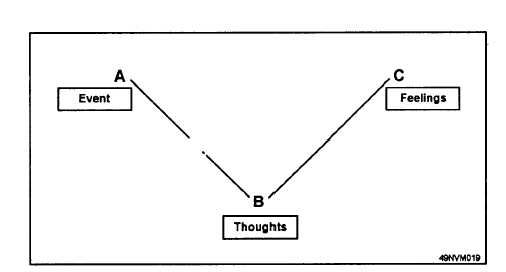| |
Figure 3-9.—ABC model.
ANALYZE THE DEMANDS.– Are they chronic
or episodic? How much control do you have over the
demand?
LOOK AT YOUR HABITS.– Are you a physical
or mental stressor? Are you participating in the right
kinds of activities for relaxation?
ANALYZE YOUR THINKING.– Is your thinking
contributing to negative feelings? If so, try to change
to more positive ways of thinking.
MARATHON ANALOGY
Marathons are designed to push an athlete 25
percent beyond normal human strength. An athlete
will “hit the wall” before completing that extra 25
percent. The body has then depleted all available
resources and is converting muscle and tissue into
energy. To avoid “hitting the wall,” nourishment
stations are set up along the course to replenish the
runners’ bodies. Experienced marathon runners stop
at the earlier placed stations to replenish before they
feel the need. They realize that the body takes 20 to
30 minutes to break down the nourishment into usable
fuel. Inexperienced runners may wait until they feel
the need to replenish. Then it is too late. They have
“hit the wall” and need to wait on their body to
convert the nourishment to fuel. We, too, need to
remind ourselves to replenish before we “hit the wall.”
Plan time to relax and reenergize before you feel the
need. This kind of self preventive maintenance will
enable you to maintain a better resistance level and
reduce mismanaged stress.
BREATHING EXERCISES
The first reaction to stress seems to be a change in
breathing. If we can control our breathing, we can
better control our situation and reactions. These
exercises can be done any time to replenish or
reenergize.
Relaxation Breathing
Breathe in deeply through the nose. Hold air in to
the count of three. Push air out through the mouth
Repeat until you feel relaxed.
Bracing
This is an energizing breathing technique. Breathe
in, filling your lungs in thirds.
First fill your
abdomen, then your upper chest, and finally the very
top of your lungs.
Slowly raise arms to shoulder
level. Clinch fists and bend to the shoulder. Slowly
outstretch arms with fists still clenched, then rapidly
bend back and forth to shoulders. Blow out and
slowly let arms relax downward.
Purifying Breathing
Breathe in, filling the lungs in thirds from the
bottom to the top. Blow out, as if through a straw, in
short bursts. Repeat several times to feel rejuvenated.
Alternating Breathing
This technique is good for headaches and sinus
problems.
Close off one nostril at a time with a
thumb and little finger while the other three fingers
3-21
|

